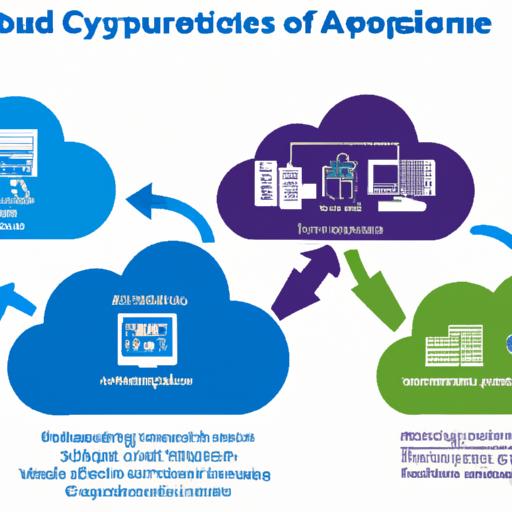Implementing Azure Hybrid Cloud Solution

As you embark on implementing an azure hybrid cloud solution, it is crucial to ensure a seamless integration between your existing infrastructure and the Azure platform. This section will guide you through the process, from assessing infrastructure requirements to configuring key components like Azure Stack and Azure Arc.
Assessing infrastructure requirements and compatibility
Before diving into the implementation process, it is essential to assess your existing infrastructure and evaluate its compatibility with Azure hybrid cloud solution. This involves considering factors such as network bandwidth, storage capacity, and security protocols. Conducting a thorough assessment will help you identify any potential gaps or limitations that need to be addressed before moving forward.
Setting up Azure Stack and its integration with on-premises infrastructure
One of the key components of Azure hybrid cloud solution is Azure Stack, which enables you to extend Azure services to your on-premises data centers. Setting up Azure Stack involves deploying the necessary hardware and software components, configuring networking and storage, and establishing the necessary connectivity between your on-premises environment and Azure.
During the setup process, it is crucial to follow best practices and ensure proper integration with your existing infrastructure. This includes establishing secure connections, implementing appropriate identity and access management policies, and enabling seamless data replication and synchronization between on-premises and Azure environments.
Configuring Azure Arc for centralized management and control
Another important aspect of implementing Azure hybrid cloud solution is configuring Azure Arc. Azure Arc allows you to manage and orchestrate resources across multiple environments, including on-premises, multi-cloud, and edge environments. It provides a unified control plane, enabling you to monitor, secure, and govern your resources from a single interface.
To configure Azure Arc, you will need to establish a connection between your resources and Azure Arc, register and onboard them to the Azure portal, and define policies and configurations to ensure consistent management across different environments. This centralized management capability empowers you to streamline operations, improve efficiency, and maintain control over your hybrid infrastructure.
By following these steps and properly implementing Azure Stack and Azure Arc, you can successfully leverage the power of Azure hybrid cloud solution, enabling seamless integration between your on-premises infrastructure and the Azure platform.
Advantages and Use Cases of Azure Hybrid Cloud Solution
As businesses strive to optimize their IT infrastructure, the Azure hybrid cloud solution emerges as a game-changer. Let’s explore the advantages and various use cases that make it an appealing choice for organizations.
A. Seamless Integration of On-Premises and Cloud Resources
With Azure hybrid cloud, you can seamlessly connect your on-premises infrastructure with the cloud. This integration allows for a unified and consistent experience across different environments, enabling efficient resource utilization. Whether you need to extend your data center capabilities, migrate workloads, or leverage cloud services, Azure hybrid cloud provides a seamless bridge between the two worlds.
B. Enhanced Security and Compliance for Sensitive Data
Security and compliance are crucial in today’s digital landscape. Azure hybrid cloud offers robust security measures to protect sensitive data and ensure regulatory compliance. By leveraging Azure’s advanced security features, organizations can implement comprehensive security controls and encryption protocols, safeguarding their data both on-premises and in the cloud. This enhanced security posture gives businesses peace of mind when adopting a hybrid cloud strategy.
C. Scalability and Flexibility for Dynamic Workloads
One of the key benefits of Azure hybrid cloud is its scalability and flexibility. It allows businesses to dynamically scale resources based on workload demands. With Azure hybrid cloud, you can seamlessly shift workloads between on-premises and the cloud, ensuring optimal performance and cost efficiency. This scalability empowers organizations to handle peak loads, adjust resources as needed, and deliver a seamless user experience.
D. Real-World Examples of Successful Azure Hybrid Cloud Implementations
Azure hybrid cloud has been successfully implemented across various industries, showcasing its versatility and impact. For instance, a healthcare organization can securely store patient records on-premises while leveraging Azure’s advanced analytics and machine learning capabilities to gain valuable insights. Similarly, a retail company can utilize Azure hybrid cloud to handle seasonal spikes in online sales by dynamically scaling resources. These real-world examples demonstrate the tangible benefits and positive outcomes that organizations can achieve with Azure hybrid cloud.
In the next section, we will explore the best practices for optimizing your Azure hybrid cloud solution to maximize its potential.
Best Practices for Optimizing Azure Hybrid Cloud Solution
As you continue to explore and implement Azure hybrid cloud solutions, it is crucial to adopt best practices that will ensure optimal performance and efficiency. Let’s dive into some key strategies for optimizing your Azure hybrid cloud deployment.
A. Monitoring and managing hybrid resources effectively
To maintain a well-functioning hybrid cloud environment, it is essential to have robust monitoring and management capabilities in place. By leveraging Azure’s monitoring tools and services, you can gain valuable insights into the performance and health of your hybrid resources.
Azure Monitor allows you to collect and analyze data from various sources, including on-premises and cloud-based resources. With its comprehensive monitoring capabilities, you can track metrics, detect anomalies, and set up alerts to proactively address any issues that may arise.
Implementing Azure Log Analytics further enhances your ability to monitor and manage your hybrid environment. By centralizing log data and utilizing powerful analytics tools, you can gain deep visibility into your infrastructure, identify trends, and troubleshoot potential problems.
B. Utilizing Azure services and tools for hybrid deployments
Azure offers a wide range of services and tools specifically designed to facilitate hybrid cloud deployments. By leveraging these offerings, you can seamlessly integrate your on-premises infrastructure with the Azure cloud, enabling a cohesive and efficient hybrid environment.
Azure Arc is a powerful tool that allows you to manage and orchestrate resources across multiple environments, including on-premises, multi-cloud, and edge locations. By extending Azure’s management capabilities beyond the Azure cloud, you can achieve centralized control and governance for your hybrid resources.
Azure Site Recovery is another invaluable service for hybrid deployments, providing robust disaster recovery capabilities. With Site Recovery, you can replicate and failover your on-premises virtual machines to Azure, ensuring high availability and business continuity in the event of a disaster.
C. Ensuring high availability and disaster recovery strategies
High availability and disaster recovery are critical considerations for any hybrid cloud deployment. By implementing appropriate strategies, you can minimize downtime and ensure the continuity of your business operations.
Azure offers various options for achieving high availability in a hybrid environment. By leveraging Azure Virtual Machines with availability sets or using Azure Kubernetes Service (AKS) for containerized workloads, you can distribute your resources across fault domains and availability zones, minimizing the impact of hardware or software failures.
Additionally, Azure Site Recovery, mentioned earlier, provides robust disaster recovery capabilities, allowing you to replicate and recover your on-premises virtual machines and services in the Azure cloud. By regularly testing and validating your disaster recovery plans, you can be confident in your ability to rapidly recover from any unforeseen disruptions.
In conclusion, by following these best practices for monitoring and managing hybrid resources effectively, utilizing Azure services and tools designed for hybrid deployments, and implementing high availability and disaster recovery strategies, you can optimize your Azure hybrid cloud solution for maximum performance, resilience, and business continuity.
Stay tuned for the next section, where we will delve into the advantages and use cases of Azure Hybrid Cloud Solution.


